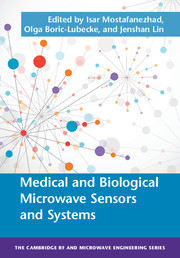Book contents
- Frontmatter
- Contents
- Contributors
- 1 Implantable Wireless Medical Devices for Gastroesophageal Applications
- 2 Embedded Wireless Device for Intracranial Pressure Monitoring
- 3 Wireless Intracranial Pressure Systems for the Assessment of Traumatic Brain Injury
- 4 Microwave Biosensors for Noninvasive Molecular and Cellular Investigations
- 5 Wearable Radar Tag Systems for Physiological Sensing/Monitoring
- 6 Physiological Radar Sensor Chip Development
- 7 Noise- and Interference-Reduction Methods for Microwave Doppler Radar Vital Signs Monitors
- 8 Biomedical Applications of UWB Technology
- Index
- References
3 - Wireless Intracranial Pressure Systems for the Assessment of Traumatic Brain Injury
- Frontmatter
- Contents
- Contributors
- 1 Implantable Wireless Medical Devices for Gastroesophageal Applications
- 2 Embedded Wireless Device for Intracranial Pressure Monitoring
- 3 Wireless Intracranial Pressure Systems for the Assessment of Traumatic Brain Injury
- 4 Microwave Biosensors for Noninvasive Molecular and Cellular Investigations
- 5 Wearable Radar Tag Systems for Physiological Sensing/Monitoring
- 6 Physiological Radar Sensor Chip Development
- 7 Noise- and Interference-Reduction Methods for Microwave Doppler Radar Vital Signs Monitors
- 8 Biomedical Applications of UWB Technology
- Index
- References
Summary
A significant reason for death and long-term disability due to head injuries and pathologic conditions is an elevation in the intracranial pressure (ICP) due to vascular compromise and secondary sequelae causing edema. ICP measurements before and after injury in a completely closed-head environment have a significant research value, particularly in the acute postinjury period. With current technology, a tethered fiberoptic probe penetrates the brain and therefore can only remain implanted for relatively short time periods. Use of the probe also can cause complications such as infection and hemorrhage and prohibit immediate (at the time of injury) and long-term measurements of ICP. A small, fully embedded, wireless ICP device may simplify clinical management and research protocols by offering a means for semi-invasive and long-term ICP measurement following brain injury. In this chapter, a new digital wireless ICP (DICP) device is described. The dynamic ICP measurement performances of both the analog ICP (AICP) devices (described in Chapter 2) and the DICP devices are evaluated in a specific traumatic brain injury (TBI) (swine) model of closed-head rotational injury.
Introduction
In Chapter 2, a prototype of an AICP device operating in the industrial-scientific-medical (ISM) band at 2.4 GHz was described that successfully simplified the surgical procedure by reducing the infection rate, the risk of hemorrhage, and the degree of tissue injury.
The AICP device was implanted in a canine model only for a static test, and hypo- and hyperventilation were used to affect variations in ICP. Dynamic ICP variations as a result of TBI in a completely closed-head environment are of paramount importance for understanding the development of a prolonged postconcussion syndrome and facilitating institution of the correct treatment at different stages, particularly in the acute postinjury period. Currently, in experimental (animal) models of TBI, a tethered fiberoptic probe (if inserted before the injury) has to be removed before an injury is induced in order to avoid significant focal damage at the point of probe insertion. Moreover, reinsertion of the probe is possible only after the animal's vital signs have stabilized. However, the act of breaching the cranium after the injury affects the fidelity of the ICP measurements. In addition, proposed noninvasive ICP (NICP) solutions, such as the pulsatility index method based on the use of trancranial Doppler, argued by Figaji et al. [1], have been shown to be insufficient for accurate ICP estimation.
- Type
- Chapter
- Information
- Medical and Biological Microwave Sensors and Systems , pp. 89 - 123Publisher: Cambridge University PressPrint publication year: 2017



